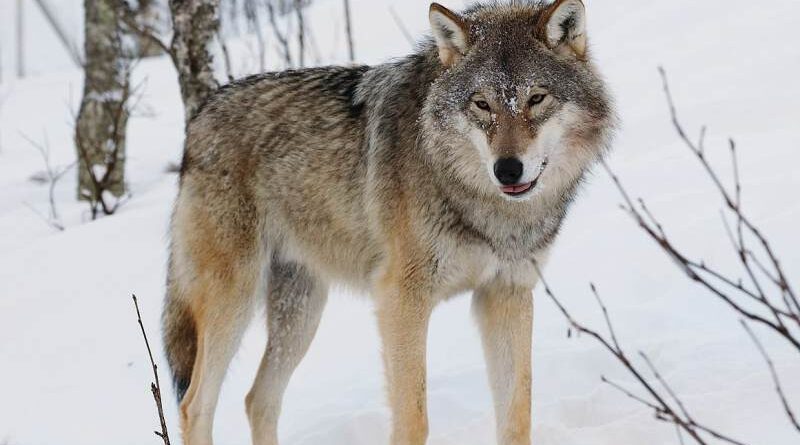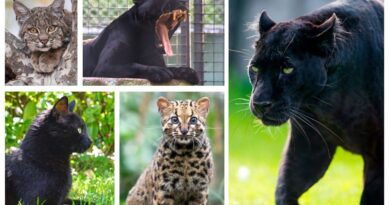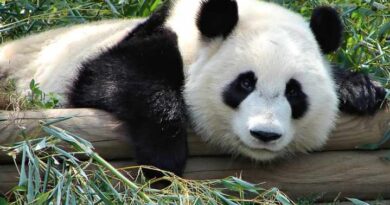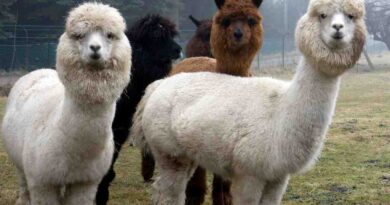WOLF
A thousand years ago, there were wolves all over Britain. People said that the wolves in the nearby forests ate the bodies that were found on the ground after the Battle of Hastings. Even people who lived in London felt unsafe, and some people who lived just outside the big city got free land in exchange for killing the wolf packs in the area.
In a book about animals that was written about 800 years ago, the wolf is described as a wild, bloodthirsty monster that is always ready to attack and eat any human it comes across. “They kill everyone who passes by in a fit of greed,” the author writes, and his scared readers probably believed every word. People used to call January “Wolf Month” because they thought that was when wolves were the most dangerous. It was also the beginning of the time to hunt wolves. Hunters and trappers were busy killing as many wolves as they could in the woods and forests all over the country.
The animals were driven back and back until they could only stay alive in the very north of Scotland and in some of the most remote parts of Ireland. Then, about 200 years ago, even those tough people who had managed to stay alive were found and killed. The wild wolf was no longer in the countryside of Britain. Men with better and better weapons have also attacked it from other parts of the world. Today, the only place it still has any power is in the harsh north. Even in the ice-cold wastelands and freezing forests, it is happening less and less. People seem to fear and hate it so much that it will probably go away completely one day.
What makes us feel this way about the wolf? Is it really that terrible? To find out, it helps to think about how our own eating habits have changed over time. Humans used to be hunters like wolves. Then, about 10,000 years ago, people learned how to farm. This was much easier than hunting because the animals could be kept in pens and fields and killed and eaten whenever they were needed. No one really needed to hunt wild animals for food anymore. This was fine for the farmers, but it was also fine for the wolves who lived nearby. Even the animals that people kept as pets were easy for them to get. Wolf packs would attack the wolves again and again, especially in the winter when they were hungry.
The wolf quickly became the farmers’ biggest enemy, and they fought back as hard as they could. They also made up crazy stories about wolves that ate people, turning the animal into a scary bad guy. This made people hate wolves even more and kept the war against them going full-steam. We still have things from that war with us today. Many people still think of the wolf as a savage enemy who wants to kill people and drink their blood. When we’re young, the story of Little Red Riding Hood scares us, and when we’re a little older, we gasp at the horror of werewolves on the big screen.
How close are these old stories and tall tales to the truth? How is the wolf in reality? One of the most surprising things about wolves is that it is almost impossible to find a real case where one killed a person. There’s a good chance that wolves ate some of the dead bodies left on old battlefields, but they didn’t kill the people themselves. Wolves don’t eat humans because they aren’t good prey for them, so they leave them alone. In reality, the wolf is not “wild,” but rather “tame.” Wolves are very careful animals that will run away from people if they get the chance. Even a wolf that has been raised by humans from the time it was a tiny cub will be scared of new people. An ordinary pet dog is far bolder.
How can we find about its way of life if it is shy and stays to itself? In the last few years, a number of tough and patient scientists have gone to the freezing Arctic wilderness, where packs of wolves still roam, and have spent many weeks and months quietly watching, filming, photographing, and taking notes on everything the animals do.
They have finally been able to show us what a wild wolf’s life is really like. In early spring, wolf cubs are born. They can’t see or move on their own, so they need a lot of loving care and protection. Three weeks before she gives birth, their mother starts digging furiously in the ground to give a special den for the cubs deep underground. She makes a place with a strong roof for the new den, like a tree trunk, some tree roots, or a big rock. Then, she digs a one-meter-long hole to get in.
This gets narrower as it goes deeper. Then she makes a long, thin tunnel that goes about 3 metres before it opens up into the nest chamber. She gives birth to her four to seven tiny cubs in this round hole, which is safe and warm.
If she has the chance, the she-wolf likes to make her den on a ground above a river or other water source. When she is taking care of her cubs, she will need to drink a lot. If she can, she will make the tunnel in her den go up to the place where she will give birth. This way, there won’t be any flooding. No matter how hard it rains outside, water will not get into the nest-chamber. Even though it’s storming outside, her cubs will be safe inside. If the mother is even a little way disturbed in her den, she takes quick action. She picks up one of the cubs in her mouth and takes it to a second den she had set up earlier. She goes back and moves the second cub, then the third, etc., until they are all safe. She always goes back to the old den one last time after moving her cubs to make sure itmakes really empty.
This system of having two dens is a special way to protect against enemies finding the first home and raiding it. Once the cubs have been in their “secret bunker” for a few weeks, they help protect themselves. They do this by digging a whole system of small tunnels that connect to each other and give them more ways to get out. We know that these tunnels were made by the cubs and not by their mother because an adult wolf would not be able to fit through them. After three or four weeks, the cubs have grown a lot and cautiously come out of the cave at the entrance of their burrow. They stumble around on unsteady legs as they look around at the outside world. They are now ready to start exploring this exciting new scene in front of them.
Quickly, all the other members of the pack come running over to meet the newcomers. Their greetings are always friendly, but sometimes they can be a little too friendly. The mother and father of the cubs will keep a close eye on what’s going on and stop anyone from getting in the way that would be too tiring for their young. As the cubs get older, different members in the pack will bring food for them. Some people will clean and care for them, while others will play with them. The cubs are already being brought into the group’s social life and made to feel comfortable.
By the time they are five months old, they are old enough to travel with the pack. One of the unique things about wolf society is that they help each other, and it’s not just the young cubs who get help. When the she-wolf has to stay in her den to give birth, the other adults in the pack will bring her food after they go hunting. The most important thing in a wolf’s life is the hunt itself. During the summer, many wolves are able to chase and catch small animals on their own, without the help of their pack companions. But when it gets cold, all the small animals that wolves eat hide underground, so the wolves have to look for bigger animals, like deer, to eat. A single wolf can’t kill a big deer by itself. It has to hunt in a group if it wants to find food.
At the start of this group hunting, a pack of wolves moves off together to find their prey. On a hard hunt, they may travel over 20 miles. At last, the leader smells a deer in the distance. If the wolves are coming from the direction of the wind, you can smell the animal from 1/10 of a mile away. The leader stops what he’s doing and stays very still.
Strange things happen after that. All of the wolves stop and, as if following a leader, turn their heads toward the faraway prey. They sniff the air, look straight ahead, and perk up their ears. Then they do something special. They all huddle together like football players in the U.S. They wait for a few seconds with their tails wagging while they stand nose to nose. I don’t know what is going on between them right now, but soon they will split up and go straight to where the scent of the prey animal is.
As the pack gets closer to the prey, they get very excited, but they are able to keep it together. They don’t act hastily. They keep looking straight ahead and wagging their tails to try not to scare the deer. They have to get as close as possible to their prey before it notices them. If the prey sees them and tries to run away, they will chase after it with great speed. If it stands its ground, they are much more wary and usually just stand and watch the animal. The act of running away is what makes them attack. They try to bring the animal as quickly as possible, but if it is a fast runner, they may have to keep going after it for a long time. During this fast part of the hunt, if they don’t catch the prey within about half a mile, they almost always give up. However, some packs have been known to keep chasing the prey for as far as 5 miles.
One of the things that makes them good hunters is that they can run for a long time without getting tired. If they have to, they just wear down their prey until it is dead. Even though they can do this, they would much rather have a short chase and a quick kill, which is almost always what happens. During the kill, the wolves catch up to the running prey and lunge at its body, biting at its sides, rump, shoulders, and nose. When they bring it down, they rip it apart and eat the meat. Each wolf eats as much meat as it can, which can be up to 10 kilos, and its stomach gets big and heavy. What the pack can’t eat, they might bury in the snow or ground. Then they can come back later, dig it up, and eat the rest of their food.
For the wolf to have such a cooperative social life, it needs a good “language of signs and signals.” Each animal must be able to explain to its companions how it feels. This is done through a lot of different postures, facial expressions, and body positions, most of which are very similar to what any pet dog would do. After all, most dogs today are just wolves that have been tamed.
Wolves use their strong jaws and teeth to catch their prey, so they try to stay out of fights with each other whenever they can. If they didn’t do this, it would be easy for them to hurt or kill each other. Because of this, submissive gestures are very important. These are ways to stand and look that say, “I give in. Do not hurt me. You are in charge.” A weak animal can say this by crouching down, pulling the corners of its mouth back, lowering its ears, and tucking its tail between its legs.
If it wants to be submissive, it can flatten its body on the ground. Still more, it can flip itself over and look up at its opponent. Few top wolves will attack a companion who shows itself in this way. By acting submissive, a disagreement can be solved without violence. Both wolves will be able to hunt again tomorrow. The weaker animal may have lost face and will always have to give way to the stronger one, but at least it is still alive and not hurt.
The opposite of what a weak animal does is what a strong one does. It stands up straight, makes its fur bristle, which makes it look even bigger, and snarls. It pulls up its upper lip to show its huge teeth. Its ears are perked up, and its stiff tail is in the air.
These are just some of the signs that wolves make with each other when they are fighting. The result is a pack in which each animal knows its place, is bossy to some and gets bossed by others. This way of figuring out their relationships makes it easier for them to work together when they are going on a hunt. The pack also uses special signals to warn other packs to stay away from their territory. Most of the time, the owners of a territory do this by cocking their legs and spraying their urine on trees and bushes to mark their territory.
They also let people know they are around by howling together. One of the pack members throws its head back and lets out a loud howl. Quickly, everyone else joins in, and soon they’re making a noise so loud that it can be heard 6 miles away. Since most wolf territories are about 6 miles wide, this means that they can quickly tell all their neighbours where they are and avoid fighting with other packs.
Clearly, the wolf is not the wild, out-of-control monster that people say it is. Now that we know so much more about it, we can respect it more and fear it less. It is the ancestor of all 400 modern dog breeds, which tells you something about what it is really like. It can’t be the bad guy if it gave us “man’s best friend.” It used to be meant to be. It only uses its sharp teeth when it is hungry; it rarely does so when it is angry. It’s a good parent, a nice friend, and a shy stranger. In the past, it may have been the farmer’s enemy, but now it should be seen as one of the most interesting large animals that still live in the wild and given a chance to live out its life wherever there is a little bit of wilderness to spare.



